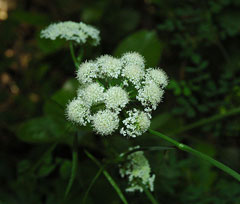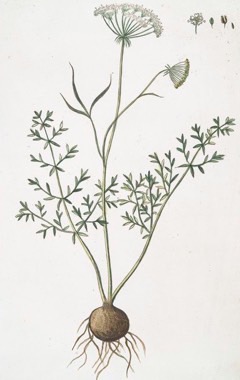 |
|
http://www.flickr.com/photos/gaspa/156565744/ |
 |
|
Translate this page:
Summary
Physical Characteristics

 Bunium bulbocastanum is a PERENNIAL growing to 0.6 m (2ft) by 0.3 m (1ft in).
Bunium bulbocastanum is a PERENNIAL growing to 0.6 m (2ft) by 0.3 m (1ft in).
See above for USDA hardiness. It is hardy to UK zone 5 and is not frost tender. It is in flower from June to July, and the seeds ripen from July to August. The species is hermaphrodite (has both male and female organs) and is pollinated by Insects. The plant is self-fertile.
Suitable for: light (sandy), medium (loamy) and heavy (clay) soils and prefers well-drained soil. Suitable pH: mildly acid, neutral and basic (mildly alkaline) soils and can grow in very alkaline soils.
It cannot grow in the shade. It prefers moist soil.
UK Hardiness Map
US Hardiness Map
Synonyms
Apium bulbocastanum. Ligusticum bulbocastanum.
Plant Habitats
Meadow; Cultivated Beds;
Edible Uses
Edible Parts: Leaves Root
Edible Uses: Condiment
Root - raw or cooked[46, 61, 115]. A delicious taste very much like sweet chestnuts when cooked[2, K], but the tubers are very small and fiddly to harvest[183]. Seed and flowers. Used as a flavouring[61, 183], they are a cumin substitute[46]. Leaves - raw or cooked. They are used as a garnish and a flavouring in much the same way as parsley[46, 61, 183].
References More on Edible Uses
Medicinal Uses
Plants For A Future can not take any responsibility for any adverse effects from the use of plants. Always seek advice from a professional before using a plant medicinally.
Astringent
Astringent[61].
References More on Medicinal Uses
The Bookshop: Edible Plant Books
Our Latest books on Perennial Plants For Food Forests and Permaculture Gardens in paperback or digital formats.

Edible Tropical Plants
Food Forest Plants for Hotter Conditions: 250+ Plants For Tropical Food Forests & Permaculture Gardens.
More

Edible Temperate Plants
Plants for Your Food Forest: 500 Plants for Temperate Food Forests & Permaculture Gardens.
More

More Books
PFAF have eight books available in paperback and digital formats. Browse the shop for more information.
Shop Now
Other Uses
References More on Other Uses
Cultivation details
See the plants native habitat for ideas on its cultivation needs. The pig nut has at times been cultivated for its edible root[61]. Although quite small in the wild, there is a potential to improve the size of this root through selective breeding and cultivation. For polyculture design as well as the above-ground architecture (form - tree, shrub etc. and size shown above) information on the habit and root pattern is also useful and given here if available. The plant growth habit is a clumper with limited spread [1-2]. The root pattern is tuberous with swollen potato-like roots [1-2].
References Carbon Farming Information and Carbon Sequestration Information
Temperature Converter
Type a value in the Celsius field to convert the value to Fahrenheit:
Fahrenheit:
The PFAF Bookshop
Plants For A Future have a number of books available in paperback and digital form. Book titles include Edible Plants, Edible Perennials, Edible Trees,Edible Shrubs, Woodland Gardening, and Temperate Food Forest Plants. Our new book is Food Forest Plants For Hotter Conditions (Tropical and Sub-Tropical).
Shop Now
Plant Propagation
Seed - sow spring in a cold frame. The seedlings only have one cotyledon[17]. Germination is usually free and quick, prick out the seedlings into individual pots as soon as they are large enough to handle and grow on for their first season in pots. Plant them out into their final positions when dormant in the autumn. The seed can also be sown in situ, but this is best done only if you have lots of seed since far fewer plants will result. Division in spring or autumn.
Other Names
If available other names are mentioned here
Native Range
EUROPE: United Kingdom (U.K.), England (south), Belgium, Switzerland, Germany, Netherlands, Croatia, Italy (incl. Sardinia, Sicily), Spain (incl. Baleares), France (incl. Corsica), AFRICA: Morocco.
Weed Potential
Right plant wrong place. We are currently updating this section.
Please note that a plant may be invasive in one area but may not in your area so it's worth checking.
Conservation Status
IUCN Red List of Threatened Plants Status :

Growth: S = slow M = medium F = fast. Soil: L = light (sandy) M = medium H = heavy (clay). pH: A = acid N = neutral B = basic (alkaline). Shade: F = full shade S = semi-shade N = no shade. Moisture: D = dry M = Moist We = wet Wa = water.
Now available:
Food Forest Plants for Mediterranean Conditions
350+ Perennial Plants For Mediterranean and Drier Food Forests and Permaculture Gardens.
[Paperback and eBook]
This is the third in Plants For A Future's series of plant guides for food forests tailored to
specific climate zones. Following volumes on temperate and tropical ecosystems, this book focuses
on species suited to Mediterranean conditions—regions with hot, dry summers and cool, wet winters,
often facing the added challenge of climate change.
Read More
Expert comment
Author
L.
Botanical References
1750
Links / References
For a list of references used on this page please go here
Readers comment
© 2010, Plants For A Future. Plants For A Future is a charitable company limited by guarantee, registered in England and Wales. Charity No. 1057719, Company No. 3204567.